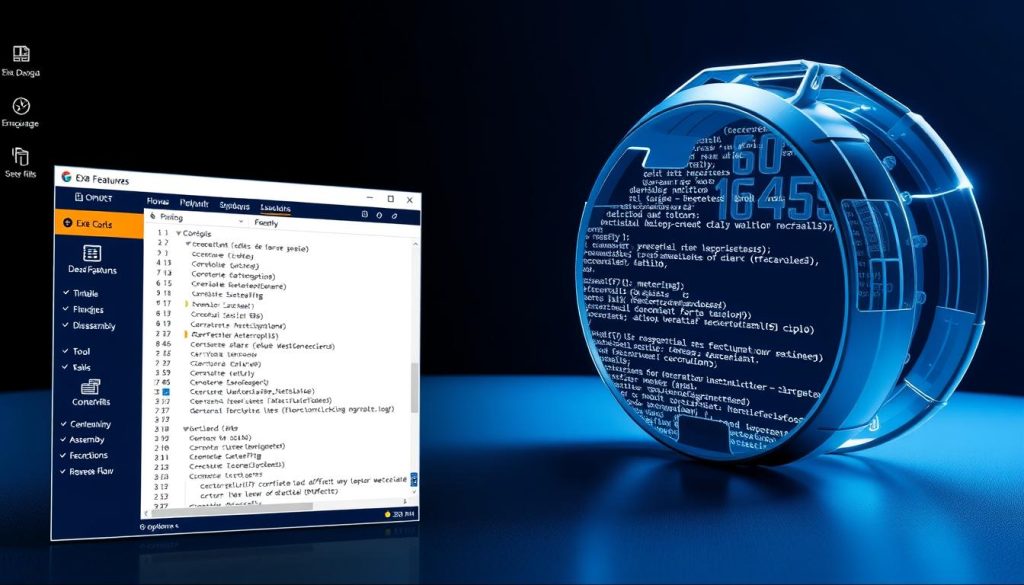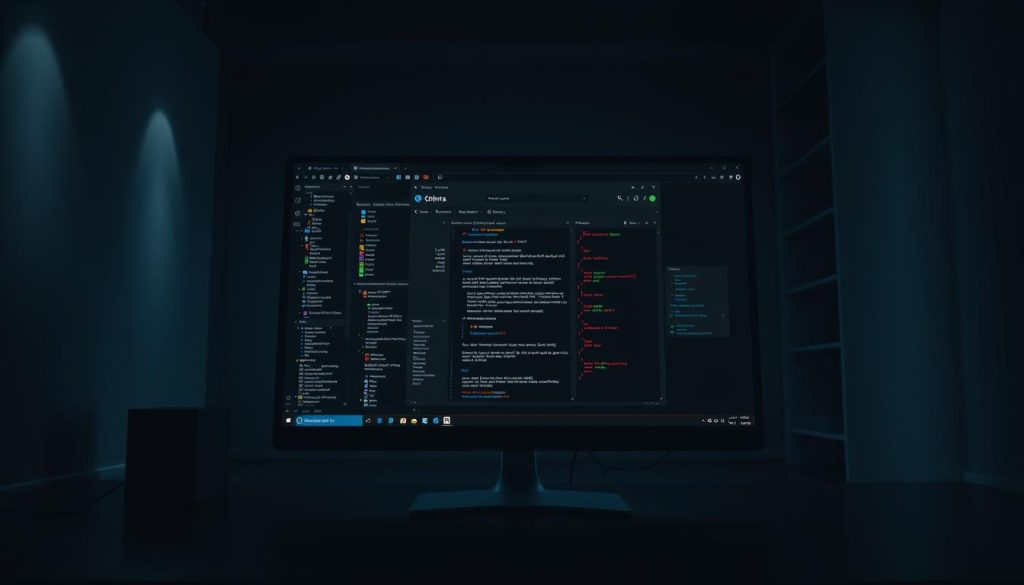Reverse engineering is key in software analysis and security. The right exe decompiler tool gives deep insights into software systems. It helps professionals understand, analyze, and improve binary code.
Developers, cybersecurity experts, and researchers use advanced exe decompiler tools. They break down executable files, showing code structures and vulnerabilities. These tools turn binary code into something we can read and understand.
Choosing the right decompilation technology is crucial in reverse engineering. Modern exe decompiler tools connect machine-level instructions to human-readable code.
Key Takeaways
- Exe decompiler tools are essential for in-depth software analysis
- Reverse engineering enables comprehensive code understanding
- Professional tools transform complex binary code into readable formats
- Security researchers leverage decompilation for vulnerability detection
- Choosing the right tool depends on specific technical requirements
Understanding EXE Decompiler Tools and Their Purpose
Executable analysis is key in software development and cybersecurity. It uses decompiler tools to turn machine code into source code. This gives deep insights into how software works and its structure.
Decompilation is more than just a technical task. It’s a powerful way to understand complex software systems. Developers and security experts use these tools for:
- Performing detailed software analysis
- Checking for security vulnerabilities
- Getting back lost source code
- Understanding old software architectures
Basic Principles of Binary Analysis
Binary analysis looks at executable files at their most basic level. Disassembly breaks down machine code into assembly language. This shows the program’s inner workings. It needs advanced algorithms to understand complex binary instructions.
Why Decompilers Are Essential for Reverse Engineering
Reverse engineering needs precise tools to decode compiled programs. Executable analysis helps researchers:
- Find malware signatures
- Understand software design
- Find performance issues
- Make software compatible
Common Use Cases and Applications
Both professionals and students use decompiler tools in many areas. They help in cybersecurity, software modernization, and more. These tools give deep insights into digital systems.
“Decompilation is not about breaking software, but understanding its intricate design.” – Cybersecurity Expert
EXE decompiler tools turn complex binary code into formats we can understand. They connect machine-level instructions with human understanding.
Top Features to Look for in an EXE Decompiler Tool
Choosing the right EXE decompiler tool is important. You need to look at key features that help with code deobfuscation and malware analysis. These tools should give deep insights into complex binary structures and be easy to use.

- Advanced code deobfuscation mechanisms
- Multi-language support
- Robust malware analysis capabilities
- Intuitive user interface
- Seamless debugging integration
Reverse engineering experts must find tools that accurately rebuild binary code. Code deobfuscation is key when checking potentially harmful executables. It’s important to have tools that can spot complex patterns.
“The right decompiler transforms binary complexity into actionable intelligence.” – Cybersecurity Expert
When picking an EXE decompiler tool, look at its performance in several areas:
| Feature Category | Critical Requirements |
|---|---|
| Decompilation Accuracy | 90%+ source code reconstruction |
| Malware Analysis | Comprehensive threat detection |
| Language Support | Multiple programming languages |
| Performance | Low resource consumption |
Knowing these features helps cybersecurity experts choose the best EXE decompiler tools for complex reverse engineering tasks.
IDA Pro: The Industry Standard for Professional Reverse Engineering
IDA Pro is the top choice for reverse engineering, known for its unmatched software protection and binary unpacking. Hex-Rays created this powerful tool. It’s favored by cybersecurity experts, malware researchers, and software developers globally.
Experts use IDA Pro for its detailed analysis. It gives deep insights into complex binary structures. This helps researchers understand and break down software mechanisms with great accuracy.
Advanced Debugging Capabilities
IDA Pro’s debugging features make it stand out. It offers:
- Comprehensive software protection analysis
- Robust binary unpacking techniques
- Seamless remote and local debugging support
- Advanced breakpoint and memory manipulation
Multi-Platform Support
IDA Pro is flexible, supporting many platforms. It works with various architectures and operating systems, including:
- Windows
- macOS
- Linux
- Embedded systems
“IDA Pro transforms complex binary analysis into an accessible and powerful investigative process.” – Cybersecurity Expert
Plugin Ecosystem Overview
IDA Pro’s plugin ecosystem greatly expands its capabilities. Users can tailor their reverse engineering workflow with community-developed plugins. This makes software analysis more efficient and focused.
For security research, malware analysis, or software development, IDA Pro is the ultimate tool. It provides a deep dive into binary exploration and understanding.
Ghidra: NSA’s Open-Source Alternative

Ghidra is a strong open-source .NET decompiler and static code analysis tool from the National Security Agency. It was released in 2019 and has quickly become popular among cybersecurity experts and software researchers.
What makes Ghidra special includes:
- Comprehensive static code analysis capabilities
- Cross-platform support for Windows, Linux, and macOS
- Advanced decompilation engine for multiple programming languages
- Scriptable interface with built-in Python integration
The tool gives developers and security experts powerful reverse engineering tools. Its .NET decompiler lets users analyze compiled code with great detail. Researchers can extract source code structures, understand program logic, and identify potential security vulnerabilities.
Ghidra is unique because it’s open-source. Security professionals can customize it, contribute to its development, and enjoy community-driven improvements. The NSA’s choice to share this tool has made advanced reverse engineering techniques more accessible.
“Ghidra represents a significant leap forward in accessible reverse engineering tools” – Cybersecurity Expert
For those looking for a versatile .NET decompiler, Ghidra is a top choice. It has impressive static code analysis features that match commercial tools. Its growing community and ongoing improvements make it a key tool for software security research.
Selecting the Right Exe Decompiler Tool for Your Needs
Choosing the right exe decompiler tool is key for reverse engineering. Developers and security experts need to think about what they need. This helps find the best tool for the job.

When picking an exe decompiler tool, consider your skill level, technical limits, and project aims. The right tool can make your reverse engineering work much easier.
Beginner vs Advanced User Considerations
Tools for reverse engineering come in all shapes and sizes, for all skill levels:
- Beginners need tools that are easy to use and have good guides
- Advanced users want tools that can be customized a lot
- The learning curve is big between simple and advanced tools
Budget and Licensing Factors
| Tool Type | Cost Range | Licensing Model |
|---|---|---|
| Open-Source | Free | Community-driven |
| Commercial | $500 – $5000 | Annual/Perpetual |
| Enterprise | Custom Pricing | Flexible Licensing |
Technical Requirements Analysis
Important technical things to think about when choosing an exe decompiler tool are:
- Does it work on your operating system?
- Does it need a lot of computer power?
- Can it work with your other tools?
- Does it support many programming languages?
“The right exe decompiler tool can turn hard binary analysis into an easy task.” – Cybersecurity Expert
By carefully looking at these points, you can pick an exe decompiler tool that fits your reverse engineering goals perfectly.
x64dbg: Deep Dive into Windows Debugging
x64dbg is a top-notch open-source debugger for Windows. It’s great for analyzing Windows executables. It lets developers and security experts dive deep into code.

- Advanced memory inspection techniques
- Real-time code manipulation
- Comprehensive Windows executable support
- Detailed register and stack tracking
Experts love x64dbg for its strong disassembly engine. It turns complex binaries into easy-to-read assembly. This helps in understanding code and finding vulnerabilities.
“x64dbg transforms complex executable analysis into an accessible and powerful experience for researchers and developers.”
Here are some key features of x64dbg:
| Feature | Description |
|---|---|
| Breakpoint Management | Supports hardware, software, and memory breakpoints |
| Plugin Architecture | Extensible framework for custom debugging modules |
| Multi-Thread Debugging | Comprehensive support for complex application environments |
For those who want to really get into Windows executable analysis, x64dbg is a must-have. It helps understand software and find security issues.
Reverse Engineering Safety and Legal Considerations
Reverse engineering is complex and involves ethics, laws, and security. It’s about protecting software and digital spaces responsibly.

Those who reverse engineer must follow strict ethics. They explore technology deeply but stay within legal limits.
Ethical Guidelines in Reverse Engineering
Ethical reverse engineering is for good reasons like:
- Security vulnerability research
- Interoperability development
- Academic and scientific investigation
- Compliance with software licensing agreements
Legal Framework Understanding
Laws on reverse engineering vary by place. Important factors include copyright laws, intellectual property rights, and industry rules. Analysts must know the legal side of their work.
“Responsible reverse engineering balances technical curiosity with legal and ethical constraints.”
Security Best Practices
For malware analysis or software protection, security is key:
- Use isolated virtual environments
- Implement strict network containment
- Utilize specialized analysis tools
- Maintain comprehensive documentation
- Follow established cybersecurity protocols
Following these steps helps researchers do their work safely and legally.
Static vs Dynamic Analysis Tools Comparison

Reverse engineering experts use two main methods: static and dynamic analysis. Each method gives different views into how software works and is built. They are key for understanding complex software systems.
Static code analysis looks at source code or compiled files without running the program. It helps find:
- potential vulnerabilities
- code structure
- security risks
- program logic
Dynamic analysis, on the other hand, watches the program as it runs. It shows how the program behaves in real time, including memory and system interactions.
| Analysis Type | Key Characteristics | Primary Use Cases |
|---|---|---|
| Static Analysis | Code examination without execution | Security auditing, code review |
| Dynamic Analysis | Runtime behavior observation | Performance testing, vulnerability detection |
Experienced reverse engineers often use both static and dynamic analysis. This combination gives a deeper understanding of complex software systems.
Choosing the right analysis method depends on the project needs, resources, and goals. Each method has its own strengths in reverse engineering.
DN Spy: Specialized .NET Decompilation

Developers and security experts need tools to understand .NET apps. DN Spy is a top choice for reverse engineering and code analysis in .NET.
DN Spy is a top-notch .NET decompiler. It helps developers turn compiled assemblies back into source code. This tool is key for code deobfuscation, letting experts dive into .NET apps.
Framework Compatibility Insights
DN Spy works well with many .NET frameworks. It supports:
- .NET Framework 2.0 to 4.8
- .NET Core
- .NET 5 and 6
- Xamarin and cross-platform frameworks
Advanced Code Recovery Features
The tool’s code recovery is unmatched. It offers:
- Precise source code reconstruction
- Debugging integration
- Symbol extraction
- Comprehensive method analysis
“DN Spy transforms compiled binaries into readable, analyzable source code with unprecedented accuracy.” – Software Reverse Engineering Journal
Developers use DN Spy to check third-party libraries and do security checks. It helps understand complex software architectures with its advanced .NET decompiler features.
Advanced Techniques in Binary Analysis
Reverse engineering experts use advanced methods to understand complex binary structures. They focus on binary unpacking to deal with encrypted and compressed files. Advanced binary analysis techniques help them break down complex code with great detail.
Disassembly has become more sophisticated, giving deeper insights into software. Experts use various strategies to decode binary environments:
- Advanced code reconstruction algorithms
- Multi-layer decryption techniques
- Sophisticated pattern recognition methodologies
Professional reverse engineers use top-notch tools to make binary unpacking easier. These methods help security experts:
- Find malware signatures
- Understand software behavior
- Spot hidden code structures
“The art of binary analysis lies in understanding what code does, not just how it appears.” – Cybersecurity Expert
| Technique | Primary Function | Complexity Level |
|---|---|---|
| Dynamic Binary Instrumentation | Runtime Code Analysis | High |
| Static Disassembly | Code Structure Examination | Medium |
| Memory Forensics | Runtime State Reconstruction | Advanced |
Modern binary analysis demands continuous learning and adaptation to emerging computational challenges. Experts must keep learning and updating their skills to keep up with new software.
Performance Benchmarks and Tool Comparison
Choosing the right exe decompiler tool is crucial. Developers and security experts need to know how different tools compare. They look at how well each tool analyzes code.
Performance benchmarks show big differences among top exe decompiler tools. The key areas to check are:
- Decompilation speed
- Memory consumption
- Code reconstruction accuracy
- Complexity handling
Speed and Resource Usage Analysis
Experts focus on tools that use few resources. Efficient static code analysis means tools that handle big files well without slowing down the system.
Accuracy Metrics Evaluation
Accuracy is key in reverse engineering. The best decompiler tools can rebuild code very accurately. Some tools can get up to 95% of the original code right.
| Tool | Speed (Files/Min) | Memory Usage | Accuracy Rate |
|---|---|---|---|
| IDA Pro | 42 | Low | 92% |
| Ghidra | 38 | Medium | 89% |
| x64dbg | 35 | High | 87% |
Developers need to weigh performance against their project needs. The best tool is fast, uses little resources, and accurately rebuilds code.
Handling Obfuscated and Protected Executables
Software protection has grown more advanced to fight reverse engineering. Developers use code deobfuscation techniques to keep their files safe. This makes it hard for security experts and reverse engineers to access them.
Experts face big challenges when working with obfuscated files. They use several methods to get through the protection:
- Static code analysis
- Dynamic runtime examination
- Specialized deobfuscation tools
Reverse engineering teams use special tools to break through tough protection. Advanced decompilation strategies help them uncover the hidden layers of obfuscation. This is how developers keep their code safe.
| Obfuscation Technique | Difficulty Level | Deobfuscation Approach |
|---|---|---|
| Control Flow Obfuscation | High | Advanced Pattern Recognition |
| Encryption Wrapping | Medium | Runtime Memory Analysis |
| Code Virtualization | Very High | Specialized VM Emulation |
Getting through obfuscated code needs a lot of technical skill and the right tools. Experts must keep learning as protection methods get better. This is a constant battle between developers and security analysts.
The art of penetrating software protection is not about breaking code, but understanding its intricate defensive mechanisms.
Those in this field need to know a lot about defensive programming and reverse engineering. They must stay up-to-date with the latest in software protection and reverse engineering.
Integration with Other Security Tools
Malware analysis and reverse engineering need a network of security tools. Experts know that one tool alone can’t protect or analyze everything. The goal is to link tools smoothly to use their strengths together.
Linking executable decompiler tools with other security tools makes a strong team for finding and studying threats. This way, experts can see software from many angles.
Workflow Optimization Strategies
Integrating tools well means paying attention to a few key things:
- How well different tools work together
- Easy ways to move data between tools
- Automated steps in analysis
- Sharing threat info in real time
Tool Chain Setup Essentials
Building a strong reverse engineering tool chain is all about flexibility and growth. The right mix of tools can really boost how well malware is analyzed.
| Tool Category | Primary Function | Integration Potential |
|---|---|---|
| Decompiler | Source code reconstruction | High |
| Dynamic Analyzer | Runtime behavior tracking | Medium |
| Threat Intelligence Platform | Contextual threat data | High |
Creating a strong security tool network takes planning and keeps getting better. By picking tools that work well together and making data sharing smooth, experts can build a powerful and flexible reverse engineering setup.
Common Challenges and Troubleshooting
Reverse engineering and binary unpacking are tough for both experts and hobbyists. They need smart ways to solve technical problems that can block their progress.
Experts often face big challenges in binary unpacking and executable analysis:
- Incomplete decompilation results
- Complex executable structures
- Anti-debugging mechanisms
- Obfuscated code segments
“Understanding these challenges is crucial for effective reverse engineering techniques.” – Cybersecurity Research Institute
To solve common problems in executable analysis, try these strategies:
- Use different decompilation tools for checking
- Apply advanced debugging methods
- Set up strong error handling systems
- Keep learning new things
Choosing the right tools is key when dealing with binary unpacking’s complexities. Each situation needs a special approach. Being flexible and adaptable is essential for reverse engineering success.
| Challenge | Recommended Solution |
|---|---|
| Code Obfuscation | Advanced static analysis techniques |
| Anti-Debugging Protections | Dynamic unpacking strategies |
| Large Executable Files | Segmented analysis approach |
Learning never stops in the world of executable analysis. Experts must keep up with new tools, methods, and research. This is how they stay ahead in their field.
Conclusion
The world of reverse engineering is changing fast. Exe decompiler tools are getting better and more important for checking software security. People working in this field need to keep up, knowing each tool’s strengths in analyzing code.
Choosing the right exe decompiler tool is a big decision. You need to think about what you need technically, your level of skill, and what you want to achieve. Tools like IDA Pro, Ghidra, and x64dbg give deep insights into software and its weaknesses.
Reverse engineering must be done with care, balancing curiosity with ethics. As cyber threats get more complex, experts need to keep learning and using new decompilation methods. This helps protect our digital world.
The future of exe decompiler tools is exciting, with AI and machine learning set to change how we analyze software. Those who keep learning and adapting will be ready to use these new technologies.

